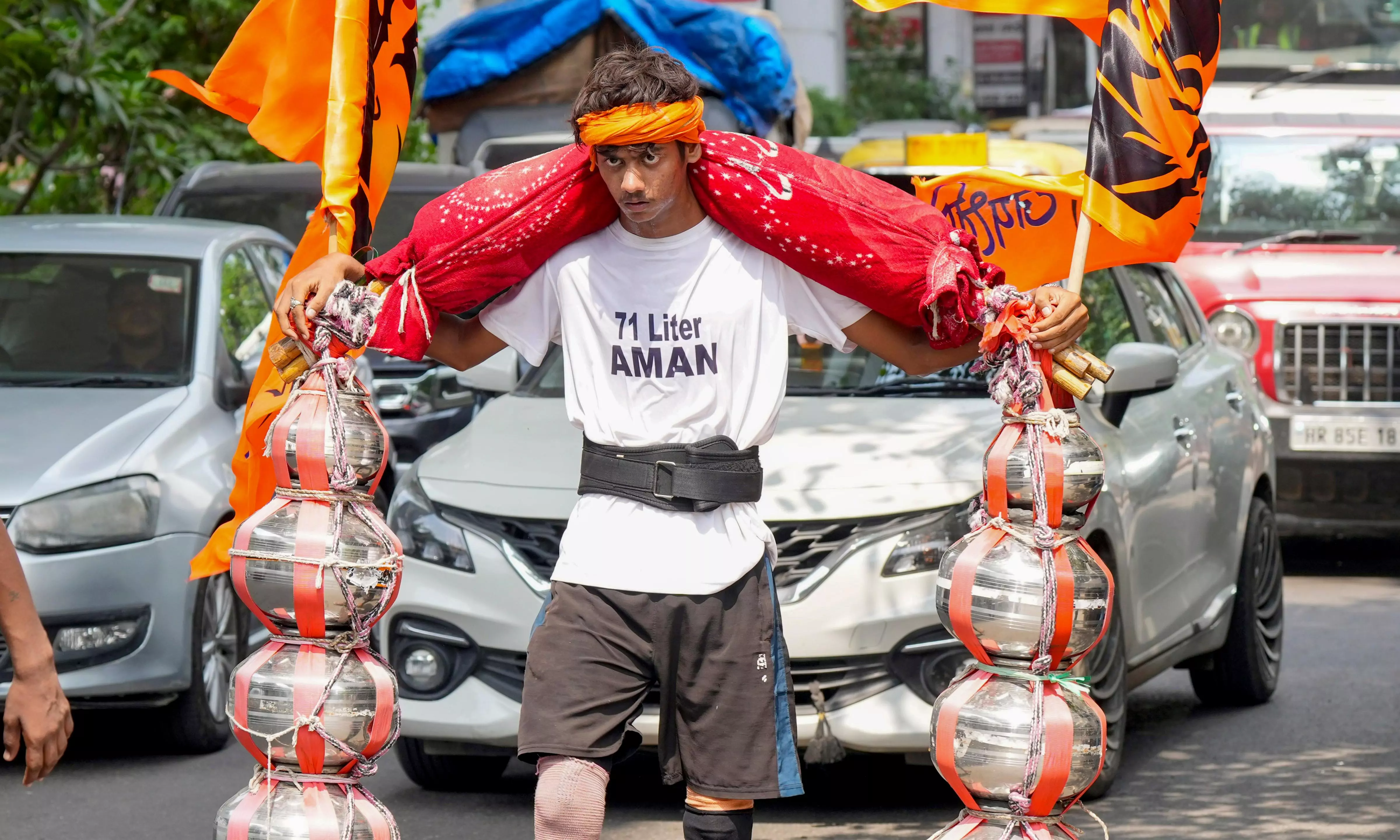
- Home
- India
- World
- Premium
- THE FEDERAL SPECIAL
- Analysis
- States
- Perspective
- Videos
- Sports
- Education
- Entertainment
- Elections
- Features
- Health
- Business
- Series
- In memoriam: Sheikh Mujibur Rahman
- Bishnoi's Men
- NEET TANGLE
- Economy Series
- Earth Day
- Kashmir’s Frozen Turbulence
- India@75
- The legend of Ramjanmabhoomi
- Liberalisation@30
- How to tame a dragon
- Celebrating biodiversity
- Farm Matters
- 50 days of solitude
- Bringing Migrants Home
- Budget 2020
- Jharkhand Votes
- The Federal Investigates
- The Federal Impact
- Vanishing Sand
- Gandhi @ 150
- Andhra Today
- Field report
- Operation Gulmarg
- Pandemic @1 Mn in India
- The Federal Year-End
- The Zero Year
- Science
- Brand studio
- Newsletter
- Elections 2024
- Events
- Home
- IndiaIndia
- World
- Analysis
- StatesStates
- PerspectivePerspective
- VideosVideos
- Sports
- Education
- Entertainment
- ElectionsElections
- Features
- Health
- BusinessBusiness
- Premium
- Loading...
Premium - Events

Since religion has become a well-funded industry over the past four decades, the yatra draws those who have the time and inclination to have a good time
As reports of violent skirmishes between the Kanwar Yatris, currently walking down national and state highways in several North Indian states on an annual religious sojourn, began being reported from far and wide, Uttar Pradesh Chief Minister Yogi Adityanath curiously asked the ‘pilgrims’, in a rare cautionary message, to exercise “self-discipline”.
He added that “only with this approach, the Kanwar Yatra will not only be a symbol of faith and devotion but also reflect the widespread belief of the common people”.
This statement was unusual for a leader who calls for no restraint among his supporters, especially when they are on a purely religious or politico-religious mission.
Yatris clash on streets
In recent days, there have been multiple reports of ostensible worshippers of Lord Shiva clashing with residents of cities, town and villages on their demarcated routes.
These confrontations have been triggered by the smallest of provocations – a passing car grazing one of the walkers or a dispute over any other minor matter.
Each of these incidents is a testimony to their arrogance because they are part of a display that has the backing and endorsement of the powerful.
An ancient pilgrimage
The Kanwar Yatra is a religious phenomenon typical to North India and has a recorded history dating to at least early 19th century, when British travellers noted coming across these pilgrims during their travels in the region.
Having grown up in a town on the Kanwar Yatra route, situated close to Haridwar, the biggest hub for the yatra which begins every year in the Hindu month of Saawan (or Shravana), and subsequently in Delhi-NCR, I have been witness to this festival’s character changing over a period of almost 50 years.
In these five decades, I have seen first-hand personal religiosity slowly ebbing out of this once austere annual ritual. Over the years this has been replaced by macho or militant Hinduism backed by institutionalised financial resources.
A rowdy lot now
What should have remained solely a pilgrimage has been given an aggressive character by administrative directives like the Uttar Pradesh government’s order this year on food stall owners to compulsorily display prominently the full name of their owners.
Unambiguously aimed at displaying the respective proprietors’ religious identity, this clearly was a majoritarian directive and aimed at economically boycotting Muslims. The Supreme Court stayed this order but the Kanwariayas are undeniably acting like a rowdy lot against all and sundry.
Financial backing from individuals and organisations, who have politically gained by stirring up unabashedly displayed religious fervor, has resulted in widespread substance abuse over the past two decades.
Pop-bhajans and dances
The resulting temporary ‘hollowness’ within the mind is fed by blaring pop-bhajans to the beats of which Kanwar Yatris gyrate.
Their ‘dance’, if it can be called so, is little but throngs of angry zonked out near-hysterical bunch of Hindu youth. They jump and obscenely shake various parts of their anatomy to cacophonic beats emanating from giant-sized speakers mounted atop trucks, mid-sized as well as big one.
Such music and the sight of youngsters whirling and walking is an affront to aesthetic sensibilities and can only pose a question within the mind: Can this ‘atmosphere’ produce tranquility within the mind for the believers to have a quiet and invisible connect with the imagination of the Almighty?
Political patronage
Over the years, such rowdyism has been feted by political leaders. There are videos galore of Uttarakhand Chief Minister Pushkar Singh Dhami washing the feet of these young men. Even Adityanath has not been far behind.
There are also numerous instances of political leaders, senior police officers and bureaucrats flying over the ghats on the banks of the Ganga in Haridwar and showering flower petals over throngs of these men.
No questions are asked on which department’s funds are being tapped for an event which is clearly religious and of just one section of society.
Various Kanwar Yatras
As a young god-fearing young lad, I would often cycle down with friends to the flanks of the main thoroughfare of our town and watch these visibly pious men carrying these heavy kanwars on their shoulders.
Most walked barefeet. The kanwar, a makeshift contraption made with bamboo and two fairly large urns filled with water from the Ganga, would be tied to dangle from the two ends.
This ritual entails devotees to head to Haridwar or other important Hindu pilgrimage towns on the banks of the ‘holy’ river. There are separate Kanwar Yatras that are taken out in Bihar and Jharkhand for which water is collected from local sources considered holy.
Transformation from 1990s
After filling up the urns with the water from the Ganga, the Yatris begin their journey to their homes and they are to return and bathe the Shivling in a Shiva temple nearest to their home. There are some devotees who instead go and make the offering at well-known temples dedicated to Lord Shiva.
This annual Kanwar Yatra was for decades a peaceful ritual although the local administration facilitated the yatris by regulating traffic. Change became visible from the late 1990s, when the cadre and network activated by the Ram Janmabhoomi agitation began to get involved in the yatra.
Initially, local units began setting up resting halts for the yatris and they secured the support of local businesses to fund charitable kitchens for those days.
Transformative changes took place during the premiership of Atal Bihari Vajpayee, when local organisers were able to mobilise far greater resources. Backing was also provided by various organisations that make up the Sangh Parivar.
Because of the resources and political clout, it became possible to divert traffic away from major highways.
Ayodhya movement and later
The Ayodhya agitation unleashed the angry Hindu youth who mouthed slogans against 'Babur ke santaan' ('descendants of Emperor Babur') and viewed the Babri Masjid as a hate symbol and a representation of Hindu subjugation that had to be demolished.
Once the work was executed in December 1992, this lot’s energies were diverted in numerous Hindutva drives and the Kanwar Yatra emerged in a few years as an occasion to display the militant Hindu youth.
They stamped their presence at every step and often targeted Muslims during the yatra, a task made easier by official and unofficial diktats like the one issued this year by Adityanath’s government.
Largest annual pilgrimage
The Kanwar Yatra, if one takes into account all the routes in different states into account, is India’s largest annual religious pilgrimage.
The majority of men who participate in this are either unemployed or engaged in menial occupations. They are in search of greater dignity and an identity which inspires awe and opens the doors of hospitality.
The physical ordeal they undergo is a route to being feted and being compensated in kind and service for a few days. The many mythologies of Lord Shiva also include those where substance abuse is not taboo.
The Shiva these kanwariyas emulate or identify with is not the one associated with divinity and considered the Supreme Lord, but the consumer of poison.
Like Shiva, these kanwariyas too are driven by the sentiment that their deviant acts during these days of a holy month are for the good of society. In pursuit of such make-believe reality, the Kanwar Yatras now do not resemble even a pale shadow of what we grew up witnessing year after year.
Ugly face of Hinduism
The Kanwar Yatras, to borrow a line from Karl Marx, have become little but an occasion for the annual dose of opium (or any other substance including alcohol).
Because religion has become such a well-funded industry over the past four decades, it continues to draw those who have the time and inclination to have a good time.
The few deeply religious who still venture out continue to be far from maddening crowds and always walk alone and away from the boisterous din. But their numbers are dwindling with every passing year as the Kanwar Yatras have become an occasion for the ugly face of Hinduism to bare itself.
(The Federal seeks to present views and opinions from all sides of the spectrum. The information, ideas or opinions in the article are of the author and do not necessarily reflect the views of The Federal.)


